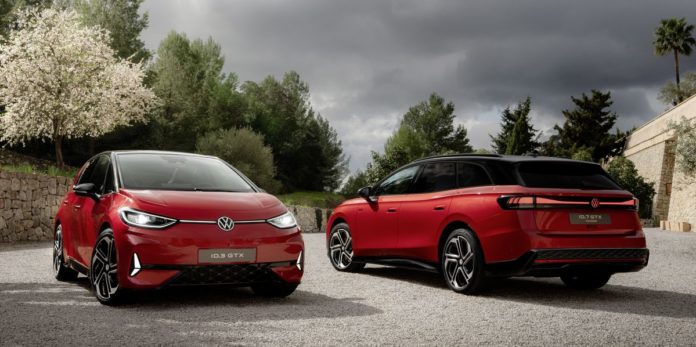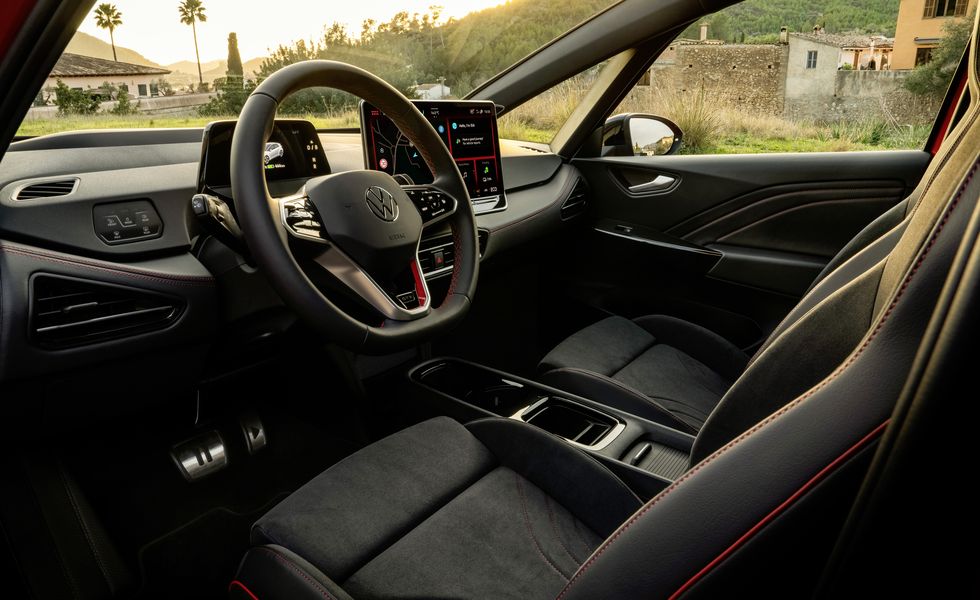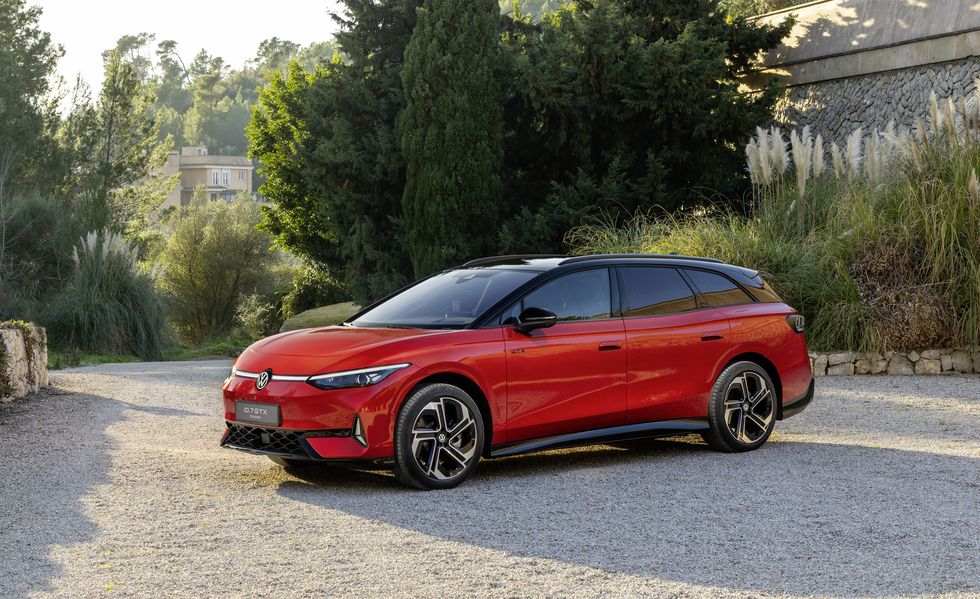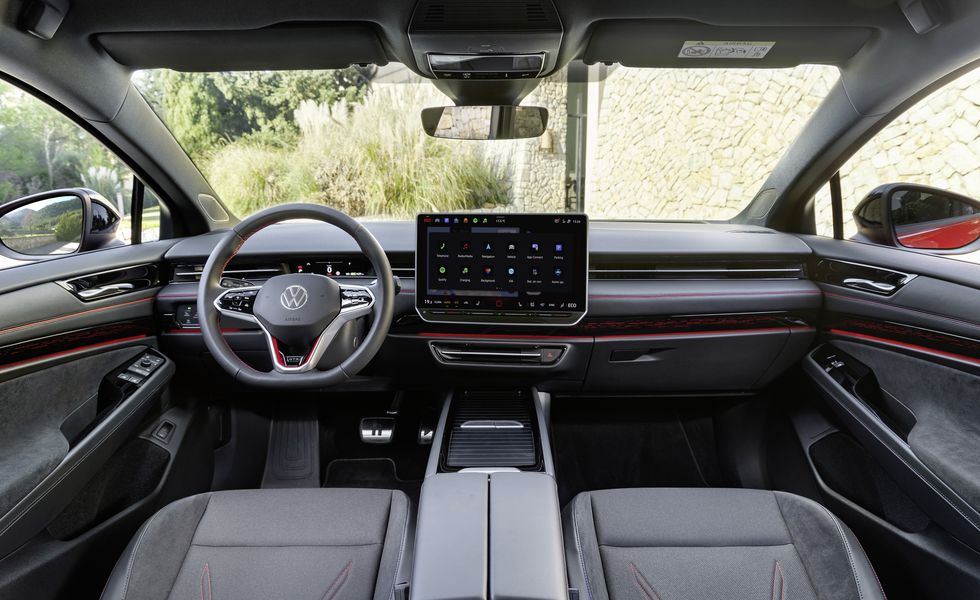- Volkswagen has revealed two sporty EVs for Europe: the ID.3 GTX and ID.7 GTX Tourer
- The ID.3 GTX hatchback has up to 322 horsepower and 402 pound-feet of torque, routed exclusively to the rear wheels.
- The ID.7 GTX Tourer is slinky station wagon fitted with an all-wheel-drive dual-motor powertrain good for 335 hp.
For Volkswagen enthusiasts, the letters “GTI” hold a lot of weight. Nearly 50 years of it, in fact, with the original Golf GTI first shown in 1975 at the Frankfurt auto show. But with the dawn of the electric age, fast VW lovers will have to get used to a new moniker. Meet the ID.3 GTX, the brand’s first electric hot hatch, and the ID.7 GTX Tourer, a sporty electric wagon. Unfortunately, neither is destined to reach American shores.
Volkswagen already revealed GTX versions of the ID.4 crossover and ID.5 coupe SUV for Europe in 2021, both of which use the dual-motor powertrain found in all-wheel-drive ID.4s sold in America. However, the new ID.3 GTX and ID.7 GTX Tourer are the first sporty electric Volkswagens to really rock our socks, owing to their eye-catching hatchback and wagon body styles.
Electric GTI Successor
The ID.3 GTX arrives in two guises. The standard version comes with 282 horsepower while the Performance model ups that to 322 hp. That means total output from the permanent synchronous motor is more than the gas-powered GTI on the low end and above the Golf R on the electric Performance model. Both GTX versions produce 402 pound-feet of torque and are rear-wheel drive. Volkswagen says the standard GTX will hit 62 mph in 6.0 seconds, while the Performance model will do the same run in 5.6 ticks. Based on our testing of the sporty gas-fed Golfs, these numbers seem conservative. Top speed for the two EV models is capped at 111 and 124 mph, respectively.
A battery with a 79.0-kWh capacity is nestled in the center of the floor for optimal weight distribution. The ID.3 GTX can charge at up to 175 kW, with the battery going from 10 to 80 percent in as little as 26 when connected to a DC fast-charger. Volkswagen predicts a range of around 373 miles on Europe’s more optimistic WLTP test cycle.
The GTX model is differentiated from ho-hum ID.3s with a new front bumper featuring a black air inlet and boomerang-shaped running lights. Gloss black also appears on the new rear diffuser and the rest of the exterior trim; snazzy 20-inch wheels are standard. The base GTX has 215-section-width tires, while the Performance wears 235s. Inside, the GTX gains sports seats with red stitching that extends to the steering wheel. The launch of the GTX also corresponds with the arrival of an upgraded infotainment system via the 12.9-inch touchscreen.
Powerful Longroof
The ID.7 GTX Tourer packs a slightly brawnier powertrain, with dual motors supplying 335 horsepower to all four wheels. The permanent synchronous motor on the rear axle is the same 282-hp unit found in the ID.3 GTX, while the front axle makes do with an asynchronous motor pushing out 108 hp. Top speed is limited to 112 mph, but no acceleration figures were shared.
The ID.7 GTX’s battery has an 86.0-kWh capacity that can charge at up to 200 kW. Charging the battery from 10 to 80 percent is expected to take under 30 minutes, according to Volkswagen. No range figures were mentioned, but the extra power and addition of all-wheel drive should drop it below the normal ID.7 Tourer’s 426-mile WLTP figure, despite the larger battery capacity.
The ID.7 GTX Tourer wears a similar bumper design as the ID.3 GTX, along with identical 20-inch wheels and gloss black trim. The interior gets similar upgrades with more heavily bolstered front seats that are heated and feature red piping. Red stitching also appears on the dashboard, doors, and steering wheel.
Sales of the VW ID.3 GTX and ID.7 GTX Tourer kick off in Europe this year, but unfortunately we will have to admire these sporty EVs from afar. The company has made no indication of bringing the compact ID.3 stateside, and while the U.S. is due to receive the sedan version of the ID.7 this year, it won’t be joined by the wagon.
Caleb Miller began blogging about cars at 13 years old, and he realized his dream of writing for a car magazine after graduating from Carnegie Mellon University and joining the Car and Driver team. He loves quirky and obscure autos, aiming to one day own something bizarre like a Nissan S-Cargo, and is an avid motorsports fan.




